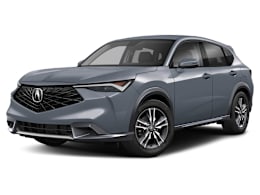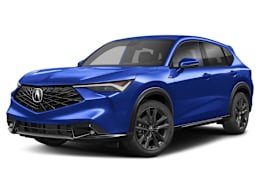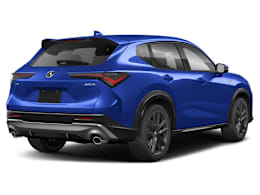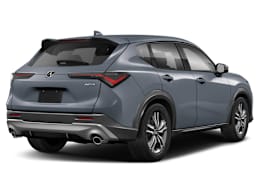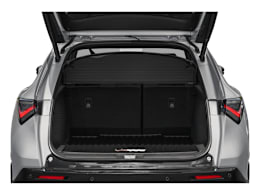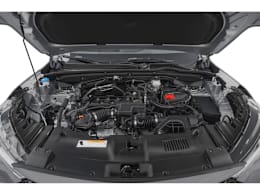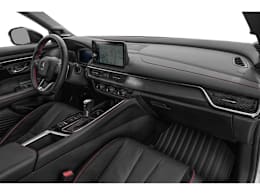The ADX is an all-new subcompact SUV that’s smaller than the Acura RDX. It’s based on the humbler Honda HR-V (Acura is Honda’s luxury brand), and packs a more powerful 190-hp, 1.5-liter turbocharged four-cylinder engine, nicer interior appointments, and a better balance between ride and handling. It’s designed to appeal to folks who want to treat themselves to a little luxury but would still like a practical SUV from an automaker known for reliability.
Many of the ADX’s flaws are shared with its direct competitors. “Entry-level luxury” cars, the lowest-cost models from prestigious brands, tend to get lower scores in our Owner Satisfaction surveys, and the reasons why are apparent with the ADX. “You can’t hide its fairly basic origins,” said one of our testers.
Just as General Motors once added fake wood trim, velour upholstery, and a vinyl roof to differentiate a classy Oldsmobile from a bare-bones Chevrolet, the ADX is essentially a more upscale version of the HR-V, visually distinguished by a more prominent grille, suede seats, and plush trim on the dashboard.
After spending many months testing the ADX, we can confidently say that it’s definitely a step up from the HR-V, but we think it feels more like a fancy Honda than an entry-level Acura. In fact, some well-equipped small SUVs from mainstream brands outperform the ADX (as do other entry-luxury models) on fuel economy, acceleration, noise, handling, and interior comfort.
However, there are some advantages to the ADX’s origins. Chief among them is that its controls are very similar to the current Honda lineup, which have some of the easiest-to-use we’ve encountered. It’s the kind of straightforward simplicity we wish all automakers embraced, and it’s a 180-degree shift away from the maddening dual-touchpad setup on Acura’s RDX, or the giant screens common on many luxury brands.
“Overall, this is a fairly pleasant vehicle,” said one of our testers. “Honestly, there’s more differentiation here compared to the HR-V than I expected. Besides having a turbo engine, the interior trim and dash design are different, although the controls and general layout are similar. It drives better than the HR-V, too, with sharper handling and a smoother ride. Still, $41,000 is steep, and a $10,000 premium over the HR-V is a tough pill to swallow. More than anything, though, the CVT kind of ruins the car for me.”
“The lack of value can't be ignored here,” said another tester. “For entry-level luxury car money, you’re getting a pretty underpowered vehicle that isn't that much quieter than the HR-V it’s based on. If you ignore the price, though, it’s actually a good package overall.”
We bought a 2025 Acura ADX A-Spec AWD for $41,350—anonymously from an area dealer, as we do with every vehicle we test—for the purpose of this road test review. Like the HR-V, our ADX was assembled in Guanajuato, Mexico.
Driving experience
Thanks to its more powerful, 190-hp turbocharged four-cylinder, the ADX feels peppier than the sluggish HR-V with its 158-hp, 2.0-liter four-cylinder. But the ADX’s continuously variable transmission (CVT) acts like a slow-to-respond middle manager that gets in between the driver’s wants and the engine’s abilities. We wish that Acura had tuned the ADX’s CVT to be a little more engaging, or had just given the car a conventional automatic transmission. The ADX needed 9.7 seconds to go from 0 to 60 mph, which is about two seconds slower than most competitors. At least it’s quicker than the HR-V, at 11.1 seconds to 60 mph. We measured fuel economy at 27 mpg overall on the recommended premium fuel. That’s 10 mpg less than the Lexus UX Hybrid, but similar to the BMW X1 and X2 and much better than the Audi Q3’s lousy 23 mpg overall.
Handling is decent, with above-average driver engagement. We found the steering to be nicely weighted and provides good feedback to the driver. The suspension does an admirable job of minimizing body lean through sharp corners, and it demonstrated commendable abilities in our accident-avoidance test. It’s relatively easy to maneuver when parking, but its turning radius is larger than some competitors'. Braking performance proved to be excellent on both dry and wet pavement.
Ride comfort is more absorbent and composed than the HR-V, and it’s also better than some entry-level luxury SUVs, such as the BMW X1 and X2. The suspension is tuned on the firm side, but it does a good job overall, keeping most bumps pretty muted. We didn’t experience any harsh moments, but every once in a while, a road imperfection will punch through in a noticeable fashion.
Cabin comfort
The ADX shares much of its interior with the HR-V. Acura added a little extra padding to parts of the dashboard, lots of sporty red stitching, and the front seats have soft micro-suede inserts. In some ways, though, the new bits make the cheaper, carryover hard-plastic Honda pieces stand out even more. It’s sort of like remodeling a kitchen by upgrading the appliances but keeping the Formica countertops. The ADX also gets uniquely weird cup holders, one of which is square.
Although some drivers liked the front seats, praising them for their pronounced side bolsters, comfortable padding, and soft and grippy micro-suede inserts, those who complained about them really disliked them. The most common grievance was that they lacked lower back and rear-end support and, therefore, were incapable of keeping some of our testers from aching on long drives. Neither front seat has lumbar adjustment, an omission that feels really cheap on a car from a luxury brand.
On the bright side, the driving position is mostly good, with plenty of headroom and a clear view of the gauges through the steering wheel. But some testers were bothered by the way the unpadded center console hemmed in their right knee, and the door armrest’s padding is quite weak. Rear-seat headroom is generous, especially considering the ADX’s small size. The seat has comfortable padding and a livable seatback angle, but the bottom cushion is too short and low to the floor, leaving adults with very little underleg support.
Controls and usability
This is where the ADX shines. It gets the same basic controls layout as the Integra and many new Honda vehicles. As such, it’s one of the simplest, easy-to-use arrangements available today. It includes dedicated knobs for temperature, fan speed, and audio volume. The heated and ventilated front seats have their own physical buttons, the climate display isn’t buried in a menu somewhere on the infotainment screen, and the gear selector is a traditional “PRND” setup. Mercifully, the infotainment controls have nothing in common with the maddening touchpad-based setup used in the RDX. We can’t believe we have to say this, but the ADX also benefits from traditional turn signals and wiper stalks, buttons for adjusting the side mirrors, and conventional door handles inside and out.
Our second-tier A-Spec model had a small center infotainment screen with physical “Home” and “Connect Phone” buttons, which answer two of the biggest questions people have with touchscreens today: “How do I get back to the main menu, and how do I connect my phone?” The menu structure itself is extremely simple, and trades customization for ease of use. Unfortunately, SiriusXM satellite radio isn’t available, and users must connect a phone and rely on Android Auto or Apple CarPlay for navigation.
The top-trim A-Spec Advance has a different infotainment screen with a more complex Google software (including built-in Google Maps) and no dedicated buttons.
Active safety and driver assistance
Standard active safety and driver assistance features include automatic emergency braking with pedestrian detection, automatic emergency braking that operates at highway speeds, blind spot warning, rear cross traffic warning, lane centering assistance, lane departure warning, lane keeping assistance, adaptive cruise control, and automatic high beams.
We’re happy to see that both a rear occupant alert system and a belt minder come standard. The former is designed to remind the driver—based on rear-door logic—to check the rear seat when they turn the ADX off to help prevent children and pets from suffering heatstroke or hypothermia if unintentionally left behind in the vehicle. The belt minder alerts the driver if a rear passenger unbuckles their seat belt during the trip.




















